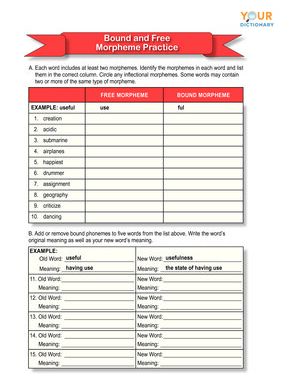

Examples of Free Morphemes
Free morphemes are considered to be base words in linguistics. Base words that can stand alone (such as “book”) are known as free bases, while bound bases (including Latin roots like “ject”) are not individual words in English. Most free morphemes can be modified by affixes to form complex words. Combining two free morphemes creates a compound word (like “mailbox”), while free morphemes modified by affixes are complex words (like “runner”).
There are two kinds of free morphemes based on what they do in a sentence: content words and function words.
Content Words
Free morphemes that make up the main meaning of a sentence are content words. Their parts of speech include nouns, verbs, and adjectives. Here are some examples of content words from everyday speech.
- Nouns: girl, hat, house, fire
- Verbs: walk, sleep, say, eat
- Adjectives: quick, nice, fun, big
These words are the most important parts of a sentence. The meaning of content words might change when combined with other morphemes, but their free morphemes will still make up the sentence’s content.
Function Words
Free morphemes also include function words. These words consist of articles, demonstratives, auxiliaries, quantifiers, prepositions, pronouns, and conjunctions. Here are some examples of free morphemes as function words.
- Articles: the, a, an
- Demonstratives: this, that, those, these
- Auxiliary Verbs: will, is, must, does
- Quantifiers: some, many, few
- Prepositions: under, over, to, by
- Pronouns: he, she, his, her
- Conjunctions: for, and, but, or
Function words serve as a grammatical connection between content words. They are not typically combined with affixes that change their meaning.
Examples of Bound Morphemes
Bound morphemes have no linguistic meaning unless they are connected to a root or base word, or in some cases, another bound morpheme. Prefixes and suffixes are two types of bound morphemes. Depending on how they modify a root word, bound morphemes can be grouped into two categories: inflectional morphemes and derivational morphemes.
Inflectional Morphemes
This type of morpheme alters the grammatical function of a word, whether it be the verb tense, number, mood, or another language inflection. The eight inflectional morphemes are organized by which part of speech they modify:
- Modify a Noun: -s (or -es), -'s (or s')
- Modify an Adjective: -er, -est
- Modify a Verb: -ed, -ing, -en
These morphemes are suffixes that change a word’s condition, but not its meaning. When they modify a base word, the rest of the sentence may need to change for proper subject-verb agreement. Some examples of these changes are:
- girl to girls
- large to larger
- smart to smartest
- walk to walking
- eat to eaten
Derivational Morphemes
A morpheme is derivational when it changes the semantic meaning of a word. Most derivational morphemes have roots in Greek or Latin. Unlike inflectional morphemes, derivational morphemes can change a word’s part of speech.
Prefixes:
- pre-
- un-
- non-
- anti-
- dis-
Suffixes:
- -ize
- -ine
- -ary
- -ate
- -ion
How you use morphemes also depends on the sentence context. Inflectional morphemes can be used in derivational contexts (e.g., using -er to create teach-er), which could change their classification. Here are some examples of the ways derivational morphemes can modify base words.
- re- + start = restart (to start again)
- un- + happy = unhappy (not happy)
- register + -ion = registration (the act of registering)
- kind + ness = kindness (the condition of being kind)

More Morpheme Practice
Understanding the morphology of a language is the first step in mastering it. Learn more about how prefixes and suffixes can modify base words, or utilize the practice worksheet on morpheme identification provided here.